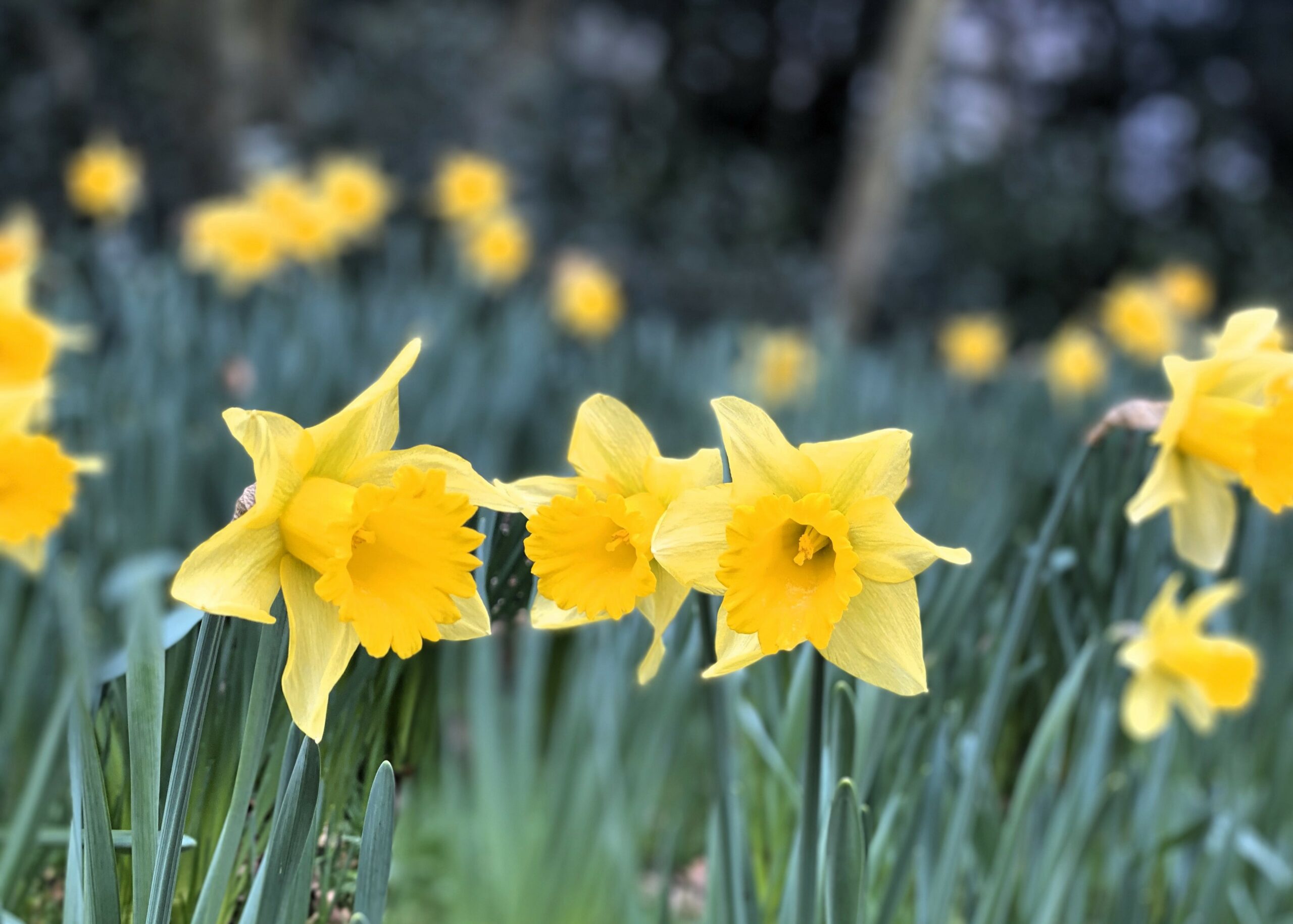Isn’t it amazing how a burst of cheerful yellow can lift your spirits? As spring begins, vibrant daffodils start to spread their sunny glow across Norfolk.
Feeling the itch to chase daffodils? We’ve curated a guide to Norfolk’s top spots where you can see these golden blooms.
Note: This post contains affiliate links. As an Amazon Associate, we earn from qualifying purchases. Please see disclosure for more information.
Be sure to sign up for our newsletter here so we can keep you up to date with what’s happening around Norfolk.
When Can You See Daffodils in Norfolk?
The timing of the blooms will vary each year depending on the weather. You may start seeing daffodils in Norfolk as early as late January and can sometimes last until mid-April. Daffodils usually reach their peak in March.
Best Places to see Daffodils in Norfolk
In Norfolk, spring means an abundance of daffodil-adorned spots, but a few stand out for their exceptional charm. Leading the pack is Long Road in Honing, boasting an awe-inspiring display of golden daffodils that’s nothing short of mesmerising.
Beyond Long Road, there are other noteworthy locations across Norfolk where daffodils paint the landscape with bright yellow hues. Whether you’re exploring historic stately homes or wandering along country lanes, Norfolk’s daffodil-filled vistas promise a memorable experience for all nature enthusiasts.
Long Road in Honing
The Long Road in Horning, near Stalham, turns into the Daffodil Mile when the blooms are out. Each year they celebrate a Daffodil Day where they have tractor rides from the village hall to see the mile of daffodils, refreshments, jacket potato lunches, home made cakes, and a tombola.
It’s funny that the first bulbs were actually meant to be fed to sheep because they were too small to sell. The former farm manager at Honing Estate was worried if they were actually safe to feed to the sheep so instead he spread them (didn’t even plant them) along the Long Road to see what would happen.
The first year only one or two bloomed but each subsequent year more of them bloomed. In 2011, money was raised to buy more daffodil bulbs so that the line of daffodils could be extended from Honing Church to the village sign at the T-junction.
Blickling Estate
Nestled just outside the town of Aylsham, Blickling Estate stands as a cherished gem in Norfolk, renowned as the birthplace of Anne Boleyn. It’s also probably the best place in Norfolk to see bluebells.
Flower enthusiasts will also enjoy the vibrant display of daffodils and other blooms in early spring. Along the temple walk, early daffodils burst forth with radiant colour.
Within the gardens and parkland, over 100,000 daffodils paint a mesmerising scene, casting a golden glow upon the landscape. Venture near the Orangery, and you’ll discover a delightful array of flora, including snowdrops, hellebore, honeysuckle, camelia, and daphne. Take a moment to breathe in the lovely fragrance.
Beyond the daffodil-strewn pathways, historic buildings like Blickling Tower offer a glimpse into the estate’s storied past. Converted into holiday homes by the National Trust, these accommodations provide a unique opportunity for guests to immerse themselves in heritage while exploring the wonders of Norfolk. Check out the options here.
Since it is a National Trust property, Blickling welcomes members to visit free of charge. For non-members, there is an admission charge to go inside the Hall and formal gardens along with a fee for parking (coin only).
Learn more about visiting Blickling Estate here.
Norwich Riverside Walk
The Riverside path holds a special place in my heart as one of Norwich’s most picturesque walks. It truly comes to life especially when the daffodils are in full bloom. For the most captivating display, head towards Cow Tower, where there is a sea of golden blooms as the path turns.
You’ll also find bright clusters of daffodils along the path between Pulls Ferry and Bishopsgate Bridge. Don’t miss the opportunity to capture a photo of Norwich Cathedral with cheerful daffodils in the foreground. This scene perfectly captures the charm and tranquillity of this historic city.
Read our guide to the Norwich Riverside Walk to learn more.
Oxburgh Hall
Amidst the picturesque landscape of Oxburgh Estate, there are many lovely gardens to explore, including the Parterre, orchard, and herbaceous border. As late winter transitions into early spring, the grounds come alive with the delicate elegance of snowdrops, offering a serene backdrop for leisurely strolls.
Amidst this tranquil setting, daffodils mingle with the snowdrops, adorning the woodland and riverbank with their cheerful blooms. The diverse range of plants showcases Oxburgh Hall’s rich history, a testament to the Bedingham family’s lasting influence since its establishment in 1482. The imposing red brick manor, encircled by a tranquil moat, stands as a symbol of power and faith, revealing the family’s deep-rooted Catholic heritage.
Inside the hall, guests can delve into the legacy of the 6th Baronet, whose visionary efforts shaped much of Oxburgh’s Victorian Gothic interiors and architectural additions. A recent £6 million conservation effort has unearthed fascinating artifacts, including a medieval prayer book, now on display for visitors to admire. Among the hall’s treasures are tapestries crafted by Mary Queen of Scots and Bess of Hardwick.
While National Trust members enjoy complimentary access, there is an entrance fee for non-members. Dogs on short leads are welcome in designated areas.
The Oxburgh Chapel Lodge, located within the grounds of Oxburgh Hall, has been transformed into an adorable holiday home by the National Trust. As a guest, you’ll enjoy the added perk of complimentary access to all National Trust sites during your stay. Discover more about this delightful lodging option here.
Learn more about visiting Oxburgh here.
Felbrigg Hall
Every spring, a breathtaking sight awaits visitors to Felbrigg Hall near Cromer as daffodils blanket the lawn in front of this majestic estate. Nestled within 520 acres of woodland, rolling parkland, and a serene lake, Felbrigg Estate offers a haven of natural beauty and historical intrigue.
The grand hall itself stands as a testament to time, with construction dating back to Tudor times. Owned by three prominent families before being gifted to the National Trust in 1969, Felbrigg Hall boasts a rich and storied past.
Visitors have the opportunity to explore both the stately home and its enchanting walled garden. For National Trust members, access to Felbrigg is complimentary, while non-members can enjoy entry to both the hall and gardens for a nominal fee.
Additionally, historic buildings such as the Game Keeper’s Cottage and the Mustard Pot Cottage, now converted into holiday homes by the National Trust, offer guests a unique chance to experience the estate’s allure up close. Staying at one of these properties not only provides a cosy retreat but also grants complimentary access to all National Trust sites. Check out the accommodation options here.
Learn more about visiting Felbrigg Hall here.
Walsingham Abbey
Walsingham Abbey may be best-known for its snowdrops, but it’s also a good spot to see daffodils. Wander through the sprawling 20-acre grounds and enjoy the enchantment of both snowdrops and daffodils, while also taking in the fascinating ruins of Walsingham Abbey.
Your admission grants you access not only to the captivating outdoor scenery but also to the intriguing exhibits within the Shirehall Museum. While reservations aren’t required, there is a modest admission fee, though Historic Houses members can explore this sanctuary for free.
While you are in the area, take time to walk around Little Walsingham, one of our favourite villages in Norfolk. Pilgrims come from all over to visit the Anglican Shrine of Our Lady of Walsingham where you can see a replica of the Holy House and try some holy water.
Read more about visiting Walsingham Abbey here.
Hindringham Hall
Sheltered in a moat straight out of a fairytale, Hindringham Hall tempts with its medieval charm and natural wonders. Originally built by Martin Hastings, a key figure in Henry Fitzroy’s court, this Tudor gem is surrounded by tranquil fishponds and a flourishing walled vegetable garden.
Once a bustling thoroughfare for transporting carp and eel to the Prior’s table in Norwich or Binham, the daffodil area at Hindringham Hall now paints a picture of springtime bliss. This former roadway has transformed into a vibrant tapestry featuring 46 varieties of daffodils, reaching their peak in early April before giving way to a carpet of delicate cow parsley.
During daffodil season, they don’t do any house tours, but the gardens welcome visitors twice a week. Their tea room serves cake, coffee, and tea in pretty bone china with views of the garden. You can book in advance or just pay with cash or card at the gate. Historic Houses members can visit the gardens for free.
Find out more here.
Disclosure: This post contains affiliate links. This means we will receive a small commission for some purchases made using links in our blog with no additional cost to you. Please be assured we would not promote any product unless we believe that our readers will also benefit. The commission does not influence the editorial content of this site.


